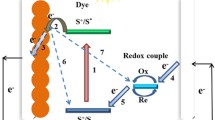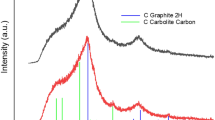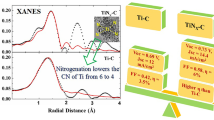Abstract
Dye-sensitized solar cells have attracted intense research attention owing to their ease of fabrication, cost-effectiveness and high efficiency in converting solar energy. Noble platinum is generally used as catalytic counter electrode for redox mediators in electrolyte solution. Unfortunately, platinum is expensive and non-sustainable for long-term applications. Therefore, researchers are facing with the challenge of develo** low-cost and earth-abundant alternatives. So far, rational screening of non-platinum counter electrodes has been hamstrung by the lack of understanding about the electrocatalytic process of redox mediators on various counter electrodes. Here, using first-principle quantum chemical calculations, we studied the electrocatalytic process of redox mediators and predicted electrocatalytic activity of potential semiconductor counter electrodes. On the basis of theoretical predictions, we successfully used rust (α-Fe2O3) as a new counter electrode catalyst, which demonstrates promising electrocatalytic activity towards triiodide reduction at a rate comparable to platinum.
Similar content being viewed by others
Introduction
As one of the most abundant and yet least collected sources of renewable energy, solar energy has attracted considerable interest in scientific research and industrial applications. Dye-sensitized solar cells (DSCs) have stood out among various photovoltaic devices because of their low cost, relative high energy-conversion efficiency and simple production procedure1,2,3,4,5. In this rapidly develo** field, finding active counter electrode (CE) material for triiodide reduction reaction (iodine reduction reaction) is of great importance for the promotion of DSCs. It has been confirmed that platinum (Pt) is a superior CE material with excellent catalytic activity, high electrical conductivity and stability. Unfortunately, the disadvantages such as the high cost and low abundance greatly restrict the large-scale application of Pt in DSCs6,7,8,9. Thus, several Pt-free alternative materials have been explored as CEs in DSCs, such as carbon materials8,10, conductive organic polymers6,11 and inorganic semiconductor materials including metal sulfides12,13, metal nitrides14,15, metal carbides16,17, metal oxides18 and copper zinc tin sulfideMaterial characterization The morphology and structure of the samples were characterized by high-resolution transmission electron microscopy (JEOL JEM-2010F, F20, 200 kV), field emission scanning electron microscopy (Hitachi S4800) and X-ray diffraction (Bruker D8 Advanced Diffractometer; Cu Kα radiation; 40 kV). The current-voltage tests of DSCs were performed under one sun condition using a solar light simulator (Oriel 91160; air mass 1.5 G). The power of the simulated light was calibrated to 100 mW cm−2 using a Newport Oriel PV reference cell system (model 91150 V). The EIS experiments and Tafel-polarization curves were measured with dummy cells in the dark by using an electrochemical workstation (Parstat 2273; Princeton). The frequency range of EIS experiments was from 100 MHz to 1 MHz with an AC modulation signal of 10 mV and bias DC voltage of 0.60 V. The curves were fitted by the ZSimpWin software. Tafel-polarization measurements were carried out with a scan rate of 50 mV s−1. Cyclic voltammetry was conducted in a three-electrode system in an acetonitrile solution of 0.1 M LiClO4, 10 mM LiI and 1 mM I2 at a scan rate of 20 mV s−1 by using a BAS 100B/W electrochemical analyser. Pt served as a CE, and the Ag/Ag+ couple was used as a reference electrode.
Additional information
How to cite this article: Hou, Y. et al. Rational screening low-cost counter electrodes for dye-sensitized solar cells. Nat. Commun. 4:1583 doi: 10.1038/ncomms2547 (2013).
References
O’Regan, B. & Grätzel, M. . A low-cost, high-efficiency solar cell based on dye-sensitized colloidal TiO2 films. Nature 353, 737–740 (1991).
Grätzel, M. . Photoelectrochemical cells. Nature 414, 338–344 (2001).
Grätzel, M. . Recent advances in sensitized mesoscopic solar cells. Acc. Chem. Res. 42, 1788–1798 (2009).
Hagfeldt, A., Boschloo, G., Sun, L., Kloo, L. & Pettersson, H. . Dye-sensitized solar cells. Chem. Rev. 110, 6595–6663 (2010).
Yum, J. -H. et al. A cobalt complex redox shuttle for dye-sensitized solar cells with high open-circuit potentials. Nat. Commun. 3, 631–638 (2012).
Ahmad, S., Yum, J. H., Butt, H. J., Nazeeruddin, M. K. & Grätzel, M. . Efficient platinum-free counter electrodes for dye-sensitized solar cell applications. ChemPhysChem 11, 2814–2819 (2010).
Papageorgiou, N. . Counter-electrode function in nanocrystalline photoelectrochemical cell configurations. Coord. Chem. Rev. 248, 1421–1446 (2004).
Kay, A. & Grätzel, M. . Low cost photovoltaic modules based on dye sensitized nanocrystalline titanium dioxide and carbon powder. Sol. Energy Mater. Sol. Cells 44, 99–117 (1996).
Gong, F., Wang, H., Xu, X., Zhou, G. & Wang, Z. -S. . In situ growth of Co0.85Se and Ni0.85Se on conductive substrates as high-performance counter electrodes for dye-sensitized solar cells. J. Am. Chem. Soc. 134, 10953–10958 (2012).
Trancik, J. E., Barton, S. C. & Hone, J. . Transparent and catalytic carbon nanotube films. Nano Lett. 8, 982–987 (2008).
Li, Q. et al. Application of microporous polyaniline counter electrode for dye-sensitized solar cells. Electrochem. Commun. 10, 1299–1302 (2008).
Wang, M. et al. CoS supersedes Pt as efficient electrocatalyst for triiodide reduction in dye-sensitized solar cells. J. Am. Chem. Soc. 131, 15976–15977 (2009).
Sun, H. et al. Dye-sensitized solar cells with NiS counter electrodes electrodeposited by a potential reversal technique. Energy Environ. Sci. 4, 2630–2637 (2011).
Li, G. R., Wang, F., Jiang, Q. W., Gao, X. P. & Shen, P. W. . Carbon nanotubes with titanium nitride as a low-cost counter-electrode material for dye-sensitized solar cells. Angew. Chem. Int. Ed. 49, 3653–3656 (2010).
Li, G. R., Song, J., Pan, G. L. & Gao, X. P. . Highly Pt-like electrocatalytic activity of transition metal nitrides for dye-sensitized solar cells. Energy Environ. Sci. 4, 1680–1683 (2011).
Wu, M., Lin, X., Hagfeldt, A. & Ma, T. . Low-cost molybdenum carbide and tungsten carbide counter electrodes for dye-sensitized solar cells. Angew. Chem. Int. Ed. 50, 3520–3524 (2011).
Jang, J. S., Ham, D. J., Ramasamy, E., Lee, J. & Lee, J. S. . Platinum-free tungsten carbides as an efficient counter electrode for dye sensitized solar cells. Chem. Commun. 46, 8600–8602 (2010).
Wu, M., Lin, X., Hagfeldt, A. & Ma, T. . A novel catalyst of WO2 nanorod for the counter electrode of dye-sensitized solar cells. Chem. Commun. 47, 4535–4537 (2011).
**n, X., He, M., Han, W., Jung, J. & Lin, Z. . Low-cost copper zinc tin sulfide counter electrodes for high-efficiency dye-sensitized solar cells. Angew. Chem. Int. Ed. 50, 11739–11742 (2011).
Wu, M. et al. Economical Pt-free catalysts for counter electrodes of dye-sensitized solar cells. J. Am. Chem. Soc. 134, 3419–3428 (2012).
Hauch, A. & Georg, A. . Diffusion in the electrolyte and charge-transfer reaction at the platinum electrode in dye-sensitized solar cells. Electrochim. Acta 46, 3457–3466 (2001).
Rossmeisl, J., Nørskov, J. -K., Taylor, C. -D., Janik, M. -J. & Neurock, M. . Calculated phase diagrams for the electrochemical oxidation and reduction of water over Pt(111). J. Phys. Chem. B 110, 21833–21839 (2006).
Calogero, G. et al. A new type of transparent and low cost counter-electrode based on platinum nanoparticles for dye-sensitized solar cells. Energy Environ. Sci. 4, 1838–1844 (2011).
Wang, H. -F., Guo, Y. -L., Lu, G. -Z. & Hu, P. . An understanding and implications of the coverage of surface free sites in heterogeneous catalysis. J. Chem. Phys. 130, 224701 (2009).
Cheng, J. & Hu, P. . Brønsted−Evans−Polanyi relation of multistep reactions and volcano curve in heterogeneous catalysis. J. Phys. Chem. C 112, 1308–1311 (2008).
Cheng, J. & Hu, P. . Theory of the kinetics of chemical potentials in heterogeneous catalysis. Angew. Chem. Int. Ed. 50, 7650–7654 (2011).
Žic, M., Ristić, M. & Musić, S. . Monitoring the hydrothermal precipitation of α-Fe2O3 from concentrated Fe(NO3)3 solutions partially neutralized with NaOH. J. Mol. Struct. 993, 115–119 (2011).
Yin, J. et al. Low-symmetry iron oxide nanocrystals bound by high-index facets. Angew. Chem. Int. Ed. 49, 6328–6332 (2010).
Fabregat-Santiago, F. et al. Correlation between photovoltaic performance and impedance spectroscopy of dye-sensitized solar cells based on ionic liquids. J. Phys. Chem. C 111, 6550–6560 (2007).
Chen, J. et al. A flexible carbon counter electrode for dye-sensitized solar cells. Carbon 47, 2704–2708 (2009).
Wu, M. et al. High-performance phosphide/carbon counter electrode for both iodide and organic redox couples in dye-sensitized solar cells. J. Mater. Chem. 22, 11121–11127 (2012).
Murakami, T. N. & Grätzel, M. . Counter electrodes for DSC: application of functional materials as catalysts. Inorg. Chim. Acta 361, 572–580 (2008).
Zakeeruddin, S. M. & Grätzel, M. . Solvent-free ionic liquid electrolytes for mesoscopic dye-sensitized solar cells. Adv. Funct. Mater. 19, 2187–2202 (2009).
Kresse, G. & Furthmüller, J. . Efficiency of ab-initio total energy calculations for metals and semiconductors using a plane-wave basis set. Comput. Mater. Sci. 6, 15–50 (1996).
Kresse, G. & Hafner, J. . Ab initio molecular-dynamics simulation of the liquid-metal–amorphous-semiconductor transition in germanium. Phys. Rev. B 49, 14251–14269 (1994).
Alavi, A., Hu, P., Deutsch, T., Silvestrelli, P. L. & Hutter, J. . CO oxidation on Pt(111): an ab initio density functional theory study. Phys. Rev. Lett. 80, 3650–3653 (1998).
Canepa, P., Schofield, E., Chadwick, A. V. & Alfredsson, M. . Comparison of a calculated and measured XANES spectrum of α-Fe2O3 . Phys. Chem. Chem. Phys. 13, 12826–12834 (2011).
Ito, S. et al. Fabrication of thin film dye sensitized solar cells with solar to electric power conversion efficiency over 10%. Thin Solid Films 516, 4613–4619 (2008).
Acknowledgements
This work was financially supported by the National Natural Science Foundation of China (20973059, 91022023, 21076076 and 21203061), Program for Professor of Special Appointment (Eastern Scholar) at Shanghai Institutions of Higher Learning, Shanghai Municipal Natural Science Foundation (12ZR1407500), Major Basic Research Programme of Science and Technology Commission of Shanghai Municipality (10JC1403200), Australian Research Council’s Future Fellowships (FT120100913) and Commission of Science and Technology of Shanghai Municipality (12ZR1442600). P.H. thanks the Chinese Government for the ‘Thousands Talents’ program.
Author information
Authors and Affiliations
Contributions
H.G.Y. and H.F.W. conceived the project and contributed to the design of the experiments and computations, analysis of the data and revising the paper. Y.H. designed and carried out the experiments, analysed the data and contributed to the analysis tools. D.W. built the theoretical modelling and analysed the computational data. Y.H. and D.W. wrote the paper. X.H.Y. carried out part of the synthetic experiments and contributed to the materials. W.Q.F. assisted with some of the experiments and was involved in interpretation of the data. B.Z. and H.J.Z. carried out the electrochemical measurements and analysed the data. P.H. and G.Z.L. participated in a series of DFT investigations in the simulations of CE materials and interpreted the computational data. All authors read and commented on the paper.
Corresponding authors
Ethics declarations
Competing interests
The authors declare no competing financial interests.
Supplementary information
Supplementary Information
Supplementary Figures S1-S10, Supplementary Tables S1-S3, Supplementary Notes 1-5 and Supplementary References (PDF 1894 kb)
Rights and permissions
About this article
Cite this article
Hou, Y., Wang, D., Yang, X. et al. Rational screening low-cost counter electrodes for dye-sensitized solar cells. Nat Commun 4, 1583 (2013). https://doi.org/10.1038/ncomms2547
Received:
Accepted:
Published:
DOI: https://doi.org/10.1038/ncomms2547
- Springer Nature Limited
This article is cited by
-
Photoinduced small electron polarons generation and recombination in hematite
npj Computational Materials (2022)
-
Hydrothermal Preparation of Ni3S4/CoS2 Composite Electrocatalytic Materials for High Performance Counter Electrodes of Dye-Sensitized Solar Cells
Journal of Cluster Science (2022)
-
Enhanced sensitivity of hydrogenated α-Fe2O3 nanoplates having {001} facets and the gas sensing mechanism
Journal of Materials Science: Materials in Electronics (2022)
-
High-Efficiency (Over 10%) Parallel Tandem Dye-Sensitized Solar Cells Based on Tri-Carbon Electrodes
Transactions of Tian** University (2022)
-
Cost effective dye sensitized solar cell based on novel Cu polypyrrole multiwall carbon nanotubes nanocomposites counter electrode
Scientific Reports (2021)





